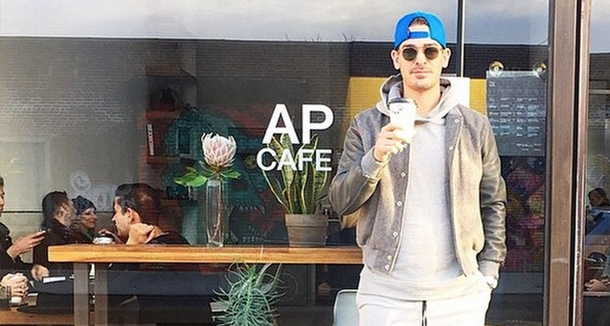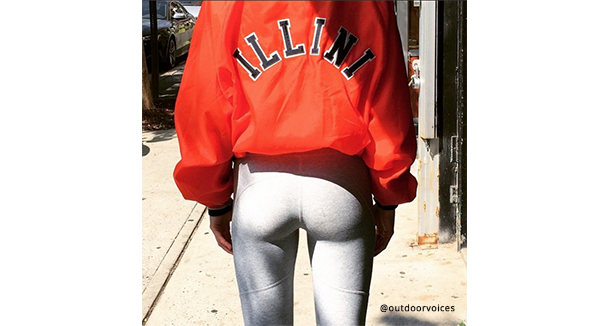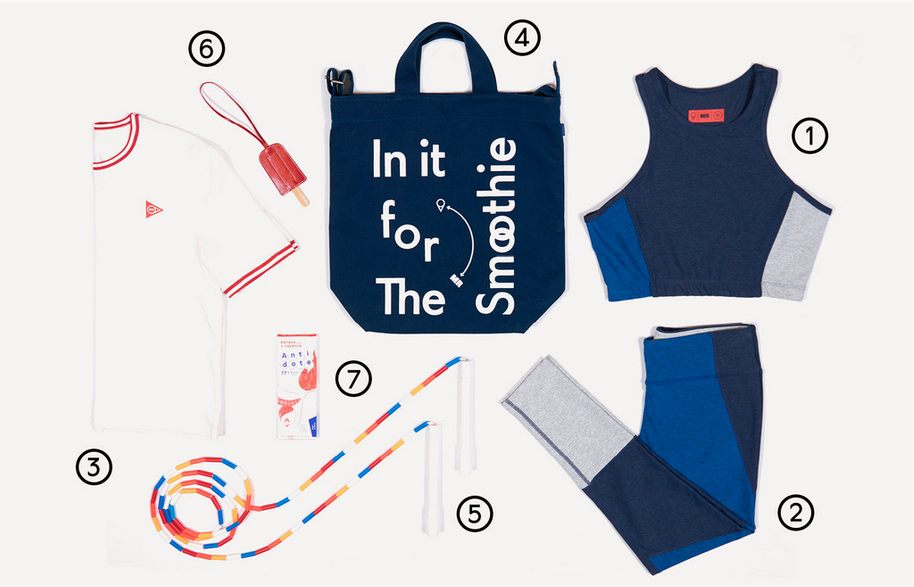CASE STUDY: 3 Growth Hacking Tactics That Put This Austin Apparel Startup Ahead of the Big Dogs
What are the first brands that come to your mind when you think athletic wear? What about your “comfies”, or clothes you wear around on the weekends, running errands?
If you’re like me, my weekend daytime apparel is a combination of big name brands thrown in with a pair of Target-brand leggings. Athletic wear is meant to be worn for sport, but has recently been making a much more visible shift into being stylish for both men and women. Meaning, you can actually go to the gym, walk into a store afterward, and not feel like you look like a bum.
Roughly half the people buying “activewear” these days are buying it for “non-active use, as casual and everyday-wear.” (source) People just want comfortable clothes to wear while they go about their day, not necessarily to go to the gym, crossfit, or hot yoga.

That’s exactly the angle that Outdoor Voices takes: “Doing Things” is their main marketing message. Their active clothing for men and women are clothes you could feel comfortable wearing going about your day. They appear stylish – not over the top. And, they’re getting attention.
The indie-brand from ATX recently raised over $1.1 million in VC funding. (source) What is it about Outdoor Voices that’s so different? How did this startup come to compete with big players like LuluLemon, UnderArmour and Nike?
In this post, I’ll take a look at how OV used their unique value proposition as a catalyst to smart growth hacking (read: lean marketing) so you can perhaps apply the same strategy to your own ecommerce company.
1. Identify Channels Where Your Customers Are Living & Speak Their Language
After I learned about Outdoor Voices, I began following them on Instagram. I didn’t browse through their profile much, just looked them up and liked their most recent couple of photos. Then, after they became integrated into my feed, I couldn’t help but pay attention to their photos. The images that caught my attention were those of their actual product and re-grams of customers wearing their gear. The brand relies on high quality imagery to drive their customer engagement. The images often showcase how good the customer’s body looks in their gear. Check out this example that got quite a bit of instalove:

Easy to see why: fans want to look like this in a pair of OV leggings, too. That’s why this image and their other product imagery works: the customer can imagine themselves in the clothing.
They also feature many images that don’t look 100% perfect – where the bodies in the images are “normal” and are just people running around “doing things”. By showing both people who appear to be very fit and those who appear to be “less athletic”, OV appeals to both demographics: something you have yet to see on a large athletic brand’s Instagram feed, like Nike.
Founder Tyler Haney says defines the brand as “a lifestyle brand approaching activity with moderation. We want to insert delight into activity without worrying about performance […] If Nike is sponsoring the professionals,” says Haney, “we’re sponsoring the recreationals.” (source)
By focusing in on their target demographic, OV is able to leverage channels like Instagram to truly speak to those customers. They know they’re not speaking to the same people Nike is, so they showcase high-quality imagery that is aligned with a “recreational” or “Doing Things” lifestyle. Haney says Instagram is their strongest point of conversation right now.
To define which channel is appropriate for you to attack, spend a significant amount of time developing customer profiles or personas. This should provide you with enough insight to identify 2-3 channels you can begin testing. Once you have enough data, put more effort / budget into the highest-performing channel to maximize results.
Check out this beginner’s guide to developing personas from Buffer.
Related: Bootstrapping Pitfalls: 6 Ways to Kill Your Ecommerce Startup
2. Leverage Influencers
One of the best ways to get attention when nobody knows your name is to get someone else to talk about you – people or brands whom your audience knows and respects. These are known as “influencers”.
Imagine the growth spurt that would take place if Steve Jobs personally endorsed your ecommerce business. That’s obviously not going to happen for multiple reasons, but you can find great people in your industry or demo-related brands to piggy-back on. Outdoor Voices has a couple of examples of leveraging influencers: one brand and one persona.
First, the brand. J.Crew discovered OV and picked them up in 2014 as their maiden voyage into athletic apparel. J.Crew had been vocal in expressing their desire not to carry an athletic line, as some of their competitors did (think Gap). However, President and Creative Director of the company, Jenna Lyons, met with OV founder, Haney, and was convinced. They picked up Outdoor Voices as part of an exclusive partnership for Holiday 2014 and Spring 2015.
Exposing the products to an already-existing audience that fits their customer profile, OV had a huge growth advantage. And grow they did. Co-founder and President Andrew Paretti said that their revenue grew tenfold in 2014. (The company has now “paused” their relationship with J.Crew in an effort to keep resources focused on growing the business.)
Their second and more recent influencer engagement: the persona. Outdoor Voices just launched a collaboration with Man Repeller, a well-known influencer in the fashion industry. Man Repeller boasts a huge following on Instagram with 916k followers. It was on their feed that I first discovered the collaboration, with this photo of Man Repeller herself, Leandra Medine, fashion authority and one of OV’s first customers:
Medine made several other posts via Instagram and the collaboration was featured on their blog, which had high engagement.
And OV plans to do more collaboration. They’ve established a list of 300 influencers who fit specific brand criteria and have launched their plans to collaborate with them as of May 2015.
Implementing an influencer strategy is a tactic that can help your ecommerce business grow immensely. According to Technorati’s 2013 Digital Influence Report, the customer conversion rate with bloggers is significantly higher than ANY other social network. (source)
How can you set up your own influencer engagement plan? Here’s 3 quick steps to get you started:
- Identify influential personas in your ecommerce business industry
- Create a plan (Read Step 1 of Groove’s post on their first 1,000+ subscribers)
- Read up on best practices in influencer engagement (Here’s a quick guide from Entrepreneur.com)
3. Bundle Your Products
So much about your online retail growth hinges on the idea of perceived value. Perception plays a huge role in your customer’s online experience. For example, suggesting similar items to the items in their cart can increase sales, or offering free shipping to your customer may justify their spending more or avoid abandoning their cart at checkout.
Another perception tactic that can grow your ecommerce revenue is product bundling, or offering multiple products to your customer at a lower price than if you were to buy each item individually. Outdoor Voices has nailed this concept with their “kit” offers.
For those of you who are active, you’ll recognize the word “kit” in reference to a cycling kit or the packet you pick up before running an organized race. These “kits” usually include everything you need from bibs to performance socks to gummy energy chews. And that’s the concept that OV has applied to what is traditionally known in ecommerce businesses as “product bundling”.

To sweeten their collaboration with Man Repeller, OV released a “limited edition” kit which included leggings, a cropped tank and top, a jump rope, a rare banana and cayenne chocolate bar, an “In it for the Smoothie” tote and a cute popsicle bag charm. By coupling this special edition product bundle with their influencer collaboration, OV was able to heighten their customer’s value perception. The price tag for this kit: $250 USD. This kit is also priced lower than their standard kit offers which are listed at $300, so the customer perceives this bundle as even more of a “deal” and encourages purchasing.
Creating product bundles for your ecommerce website should be well-planned. We recommend considering various bundling options:
- Main product + accessories
- Main product + complementary products
- Main product + similar product
The best strategy is to observe and annotate how other brands are successfully accomplishing this. What do you like / dislike about their strategy? How can you change or implement it into your own store?
Taking on the Big Dogs
With Outdoor Voices’ early growth, they were poised to scale and have recently raised $1.1M in funding with investors who’ve also invested in companies like Warby Parker. Their smart decisions in early traction and stamps of approval from big-name influencers have enabled OV to be performing at the competitive level they’re currently riding. I look forward to watching them take on the juggernauts of athletic wear and seeing exactly where this new fashion of “Doing Things” apparel leads.
Comments? Let me know below.






